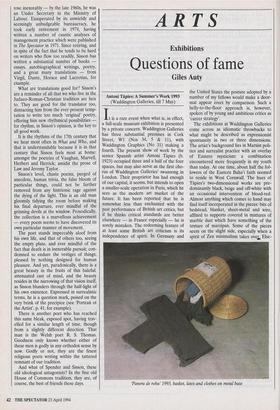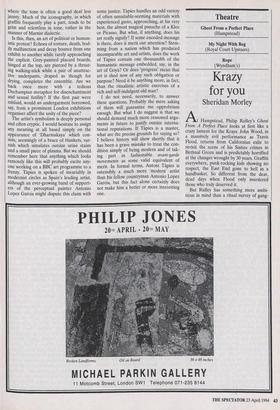ARTS
Exhibitions
Questions of fame
Giles Auty
It is a rare event when what is, in effect, a full-scale museum exhibition is presented by a private concern. Waddington Galleries has three substantial premises in Cork Street, W1 (Nos 34, 5 & 11), with Waddington Graphics (No 31) making a fourth. The present show of work by the senior Spanish artist Antoni Tapies (b. 1923) occupied three and a half of the four spaces, but may also serve as the first cho- rus of Waddington Galleries' swansong in London. Their proprietor has had enough of our capital, it seems, but intends to open a smaller-scale operation in Paris, which he sees as the modern art market of the future. It has been reported that he is somewhat less than enchanted with the past performance of British art critics, but if he thinks critical standards are better elsewhere — in France especially — he is sorely mistaken. The redeeming feature of at least some British art criticism is its independence of spirit. In Germany and the United States the posture adopted by a number of my fellows would make a door- mat appear erect by comparison. Such a belly-to-the-floor approach is, however, spoken of by young and ambitious critics as `career strategy'.
The exhibitions at Waddington Galleries come across as idiomatic throwbacks to what might be described as expressionist spontaneity in two or three dimensions. The artist's background lies in Marxist poli- tics and surrealist practice with an overlay of Eastern mysticism: a combination encountered more frequently in my youth than today. At one time,, about half the fol- lowers of the Eastern Baha'i faith seemed to reside in West Cornwall. The hues of Tapies's two-dimensional works are pre- dominantly black, beige and off-white with an occasional intervention of blood-red. Almost anything which comes to hand may find itself incorporated in the pieces: bits of bedstead, blanket, sheet-metal and wire, affixed to supports covered in mixtures of marble dust which have something of the texture of marzipan. Some of the pieces seem on the slight side, especially when a spirit of Zen minimalism takes over, Else- Tanera de roba' 1993, basket, latex and clothes on metal base where the tone is often a good deal less jaunty. Much of the iconography, in which graffiti frequently play a part, tends to be grim and relentless in tone, rather in the manner of Marxist dialectic.
Is this, then, an art of political or human- istic protest? Echoes of torture, death, bod- ily malfunction and decay bounce from one exhibit to another while rarely approaching the explicit. Grey-painted placard boards, hinged at the top, are pierced by a thrust- ing walking-stick while a pair of unattrac- tive underpants, draped as though for drying, completes the ensemble. Are we back once more with a tedious Duchampian metaphor for disenchantment and sexual futility? If the first pair were mislaid, would an undergarment borrowed, say, from a prominent London exhibitions organiser affect the unity of the piece?
The artist's symbolism is deeply personal and often cryptic. I would hesitate to assign any meaning at all based simply on the appearance of `Dharmakaya' which con- sists, seemingly of a brace of blankets, var- nish which simulates outsize urine stains and a small piece of plasma. But we should remember here that anything which looks remotely like this will probably excite any- one working on a BBC art programme to a frenzy. Tapies is spoken of invariably in modernist circles as Spain's leading artist, although an ever-growing band of support- ers of the perceptual painter Antonio Lopez Garcia might dispute this claim with some justice. Tapies handles an odd variety of often unsuitable-seeming materials with experienced gusto, approaching, at his very best, the almost magical panache of a Klee or Picasso. But what, if anything, does his art really signify? If some encoded message is there, does it merit our attention? Stem- ming from a nation which has produced incomparable art and artists, does the work of Tapies contain one thousandth of the humanistic message embedded, say, in the art of Goya? Or does 'progress' mean that art is shed now of any such obligation or purpose? Need it be anything more, in fact, than the ritualistic artistic exercises of a rich and self-indulgent old man?
I do not need, necessarily, to answer these questions. Probably the mere asking of them will guarantee me opprobrium enough. But what I do suggest is that we should demand much more reasoned argu- ments in future to justify outsize interna- tional reputations. If Tapies is a master, what are the precise grounds for saying so? I believe history will show shortly that it has been a grave mistake to treat the con- dition simply of being modern and of tak- ing part in fashionable avant-garde movements as some valid equivalent of merit. In formal terms, Antoni Tapies is ostensibly a much more 'modern' artist than his fellow countryman Antonio Lopez Garcia, but this fact alone certainly does not make him a better or more interesting one.



























































 Previous page
Previous page